Reviewer's Note: The Ramp Up (RU) and Ramp Down (RD) samples of the C2H were provided by Dereelight review.
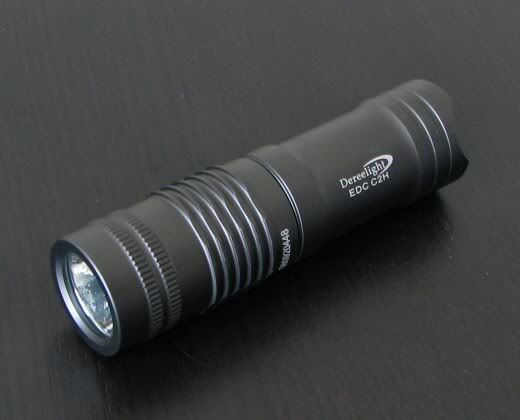
Manufacturer Specs:
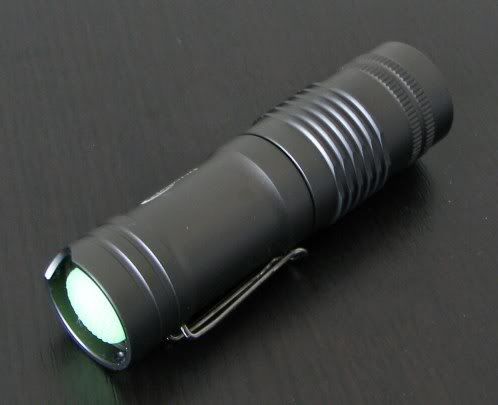
The C2H is Dereelight's first attempt at a small EDC (everyday carry) light. Their approach has a number of unique aspects - e.g. keep it as small as possible, but still highly customizable and upgradeable, and maximally driven for a 1xRCR/CR123A light. oo:
oo:
You can purchase it in both ramp up (RU) and ramp down (RD) versions, with identical output levels (i.e. only the sequence is different). Both versions have a memory mode to retain the last setting used. My two samples were of the WC tint Q5 Cree emitter, but 5A Q3 and a limited number of R2 emitters are also available. Price varies depending on configuration, but is typically ~$65. Emitter pill upgrades are also available.
The lights were identical in build, so all the pics below are from the RD version.
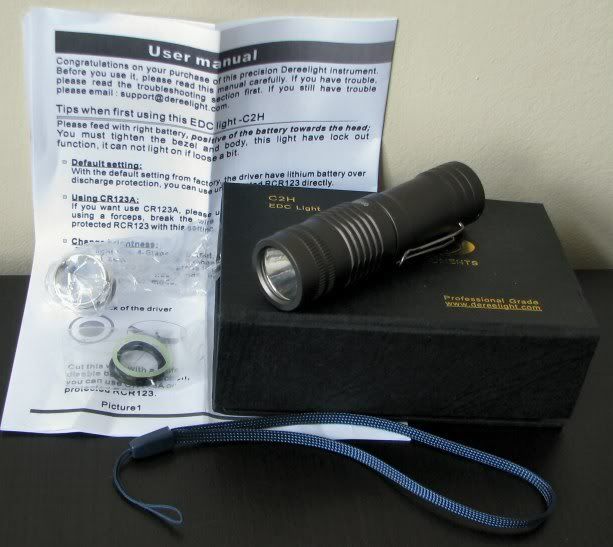
The lights come in hard cardboard boxes with magnetic closing flaps. Inside, you'll find the light encased in cut-out foam with instruction manual, additional reflector (SMO and OP included, one installed in the light), extra o-rings, and wrist lanyard.
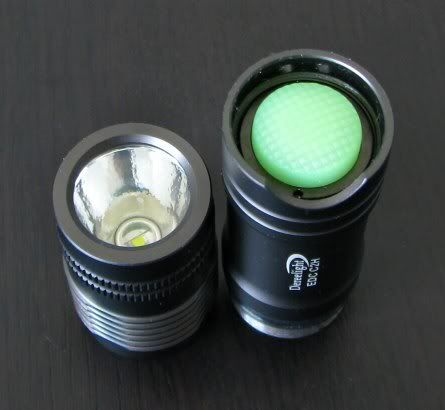
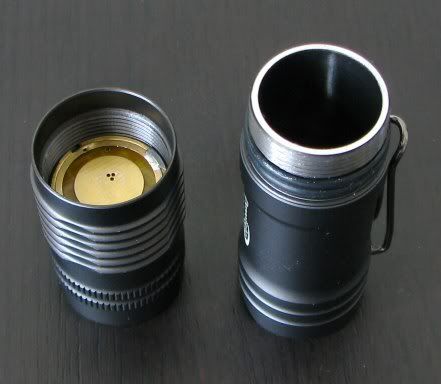
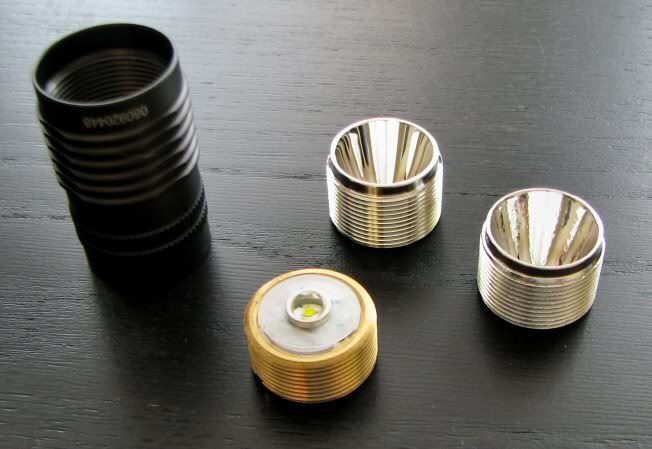
As you can see, the light includes a bezel-pointing clip and can tailstand. The forward clicky switch has a good feel and is easy to access (you can un-screw the retaining ring around the tailcap cover, just like the Nitecore Extreme).
User interface is press for momentary on, click for lock-on Advance modes by soft-pressing the clicky. Light uses PWM for low modes, but at such a high frequency that I can't detect it. :thumbsup:
The pill and reflectors are also easy to access and replace.
Note that on my RU sample, there was a small spring soldered onto the center of the contact disc in the head (not shown in the RD pics here). I don't know if this is now standard on C2H lights. Aside from this, there are no visible differences between my RU and RD samples.
Labels are quite clear and sharp, and I personally like dark grey natural HA colour. GITD rings and tailcap button are fairly bright by GITD standards.
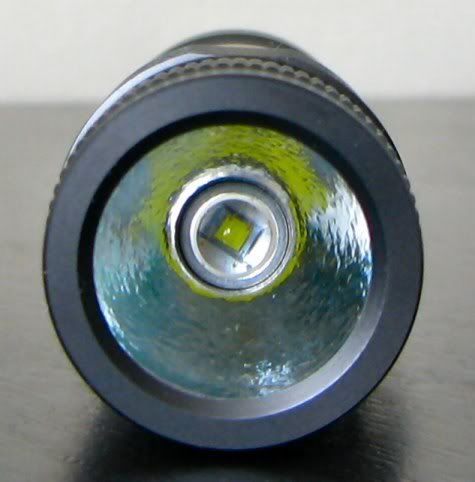
Shown above is the textured (OP) reflector, but the SMO is exactly the same dimensions. Here is how their beam patterns differ (both WC Q5):
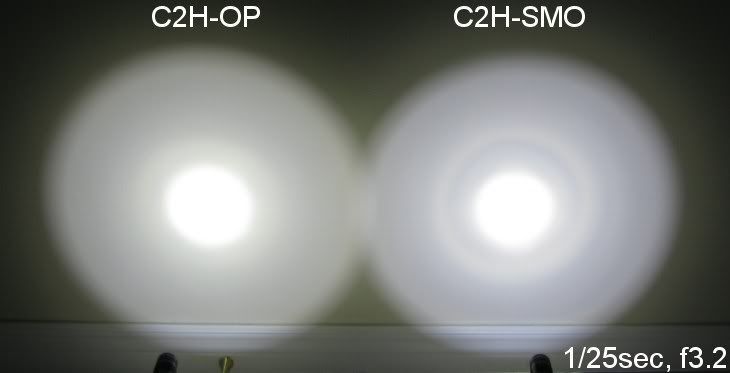
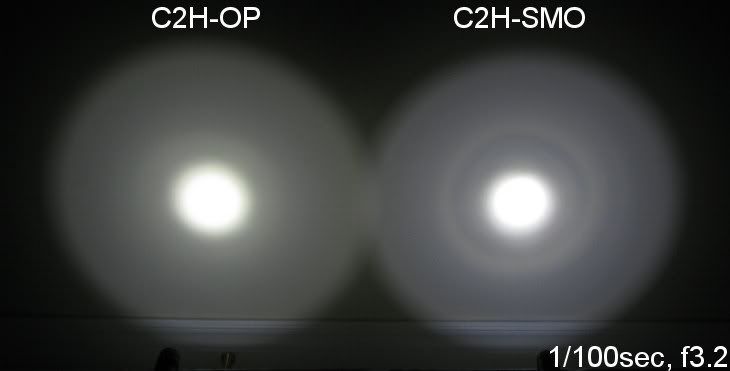
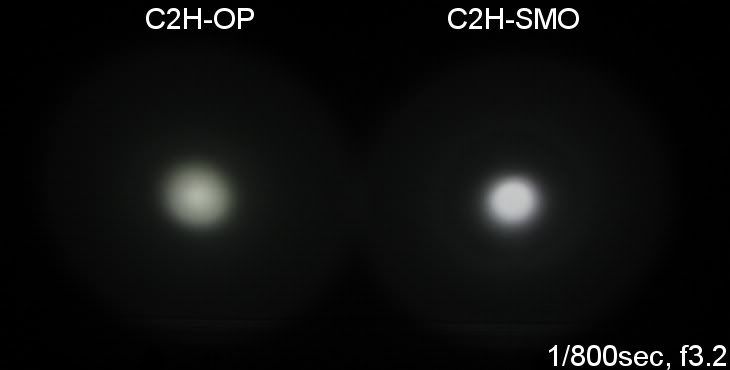
As you can see, the SMO reflector throws further, but has a more traditionally ringy Cree beam. Note that the SMO produces a tightly defined hotspot, with relatively little corona (reminiscent of the Olight 2-stage reflector, IMO).
A key feature of the C2H is the low-voltage Li-ion shut-off circuit (on by default). This allows you to run non-protected RCRs in the light safely. But it prevents you from running primary CR123A (which are lower voltage to start with). If you want to run CR123A, you need to cut the circuit trace shown on the contact surface in the head (see pics below)
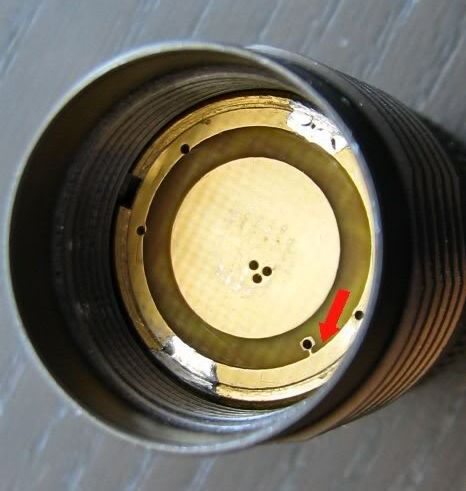

You don't need to be as thorough as I was above - a slight cut is all that is required. You can restore low-voltage shut-off by re-soldering the contact.
Comparisons

From left to right, Duracell CR123A battery, Dereelight C2H, Nitecore EX10, Lumapower Incendio V1, JetBeam Jet-II PRO, Nitecore Extreme, Novatac 120P
As you can see, the C2H is quite small for a heavily-driven light, not much bigger than the Indendio or EX10.
For beamshots, below is a comparison of the C2H with OP reflector to some other lights, all lights on AW RCR (black label) on max, ~0.5 m from a white wall.
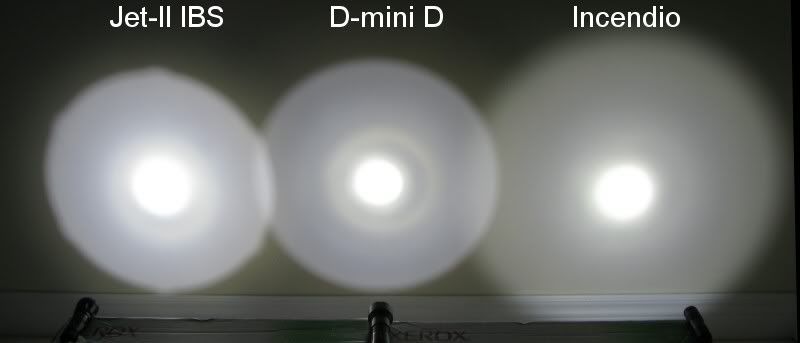
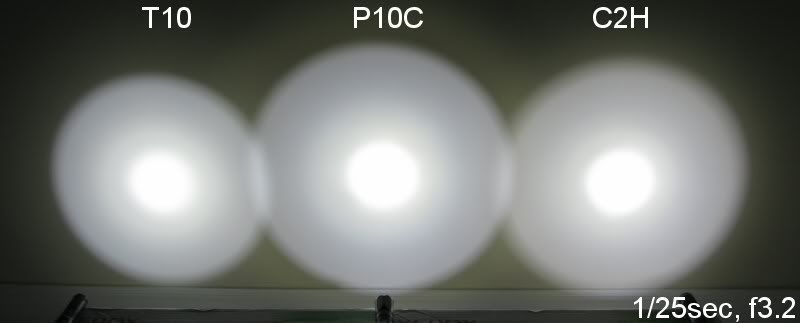
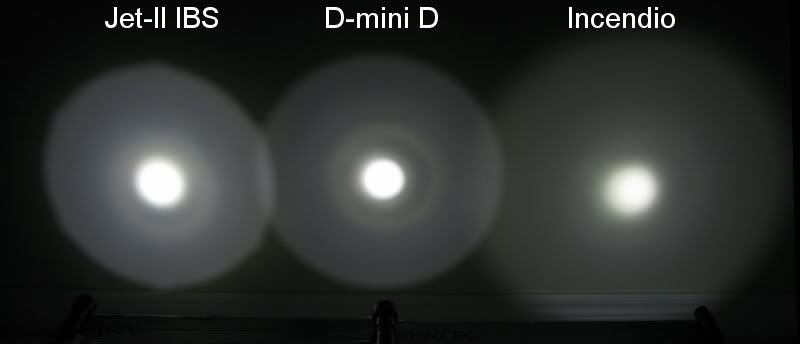
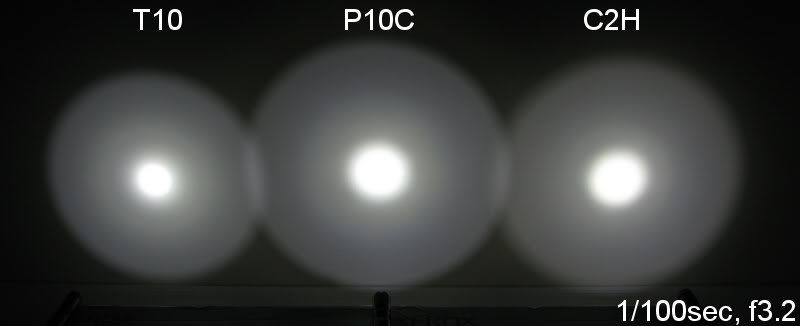
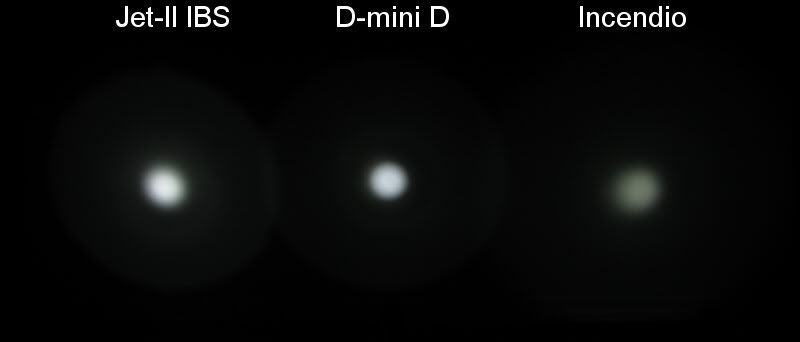
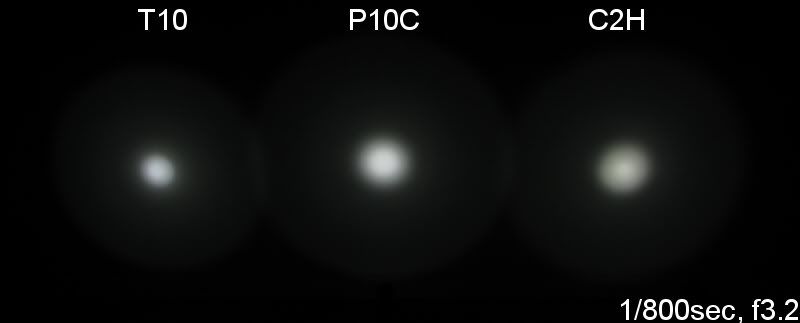
Testing Method: All my output numbers are relative for my home-made light box setup, a la Quickbeam's flashlightreviews.com method. You can directly compare all my relative output values from different reviews - i.e. an output value of "10" in one graph is the same as "10" in another. All runtimes are done under a cooling fan, except for the extended run Lo/Min modes which are done without cooling. Throw values are the square-root of lux measurements taken at 1 meter from the lens, using a light meter.
Throw/Output Summary Chart:
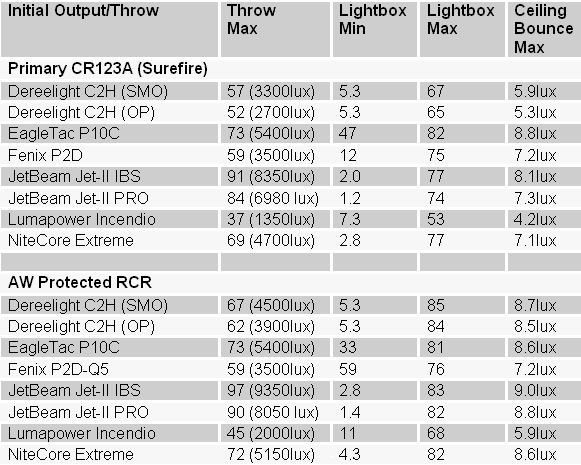
As you can see, the C2H is definitely one of the bright single cell EDC lights on RCR, at least initially. Scroll down to the runtimes for a more thorough output analysis. Throw is quite good for the size.
Output/Runtime Comparison:
For these comparisons, I've labelled the lights output levels from lowest output to max output in order (i.e. L1 is lowest, L4 is highest). I've noticed on the forums that most people refer to these levels as Lo-Med-Hi-Burst.
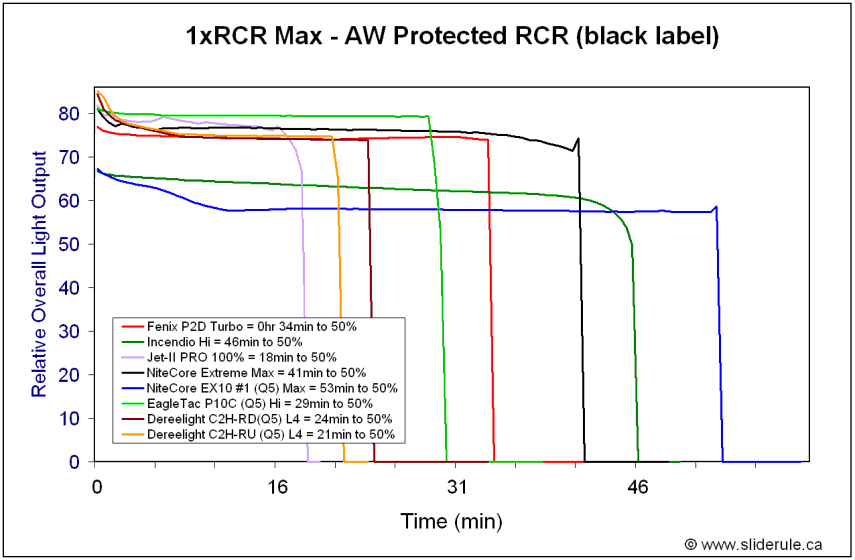
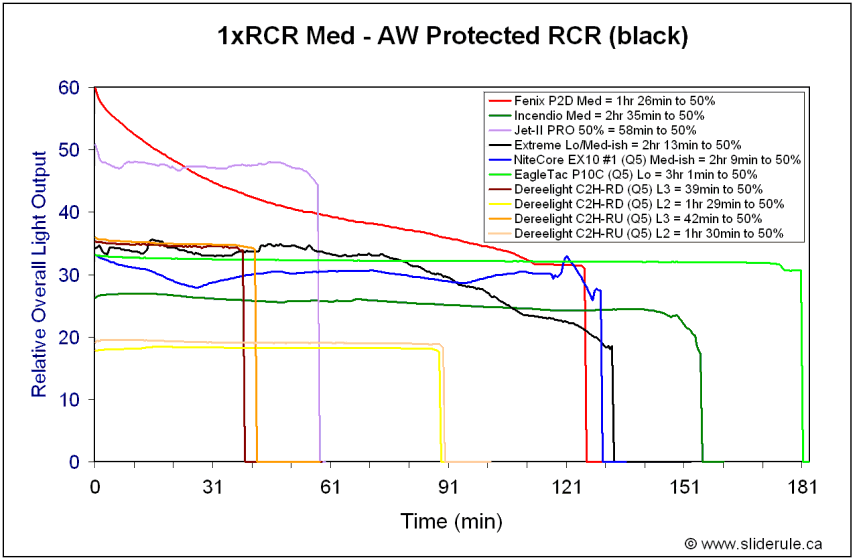
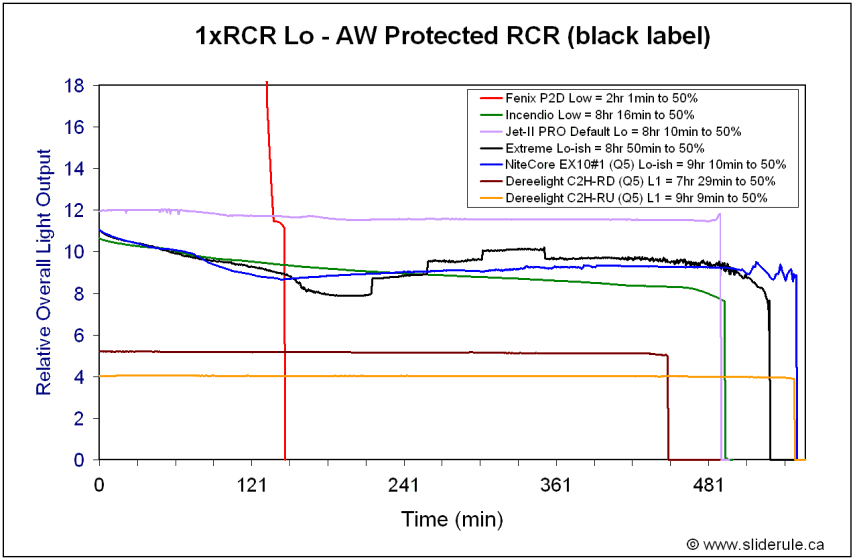
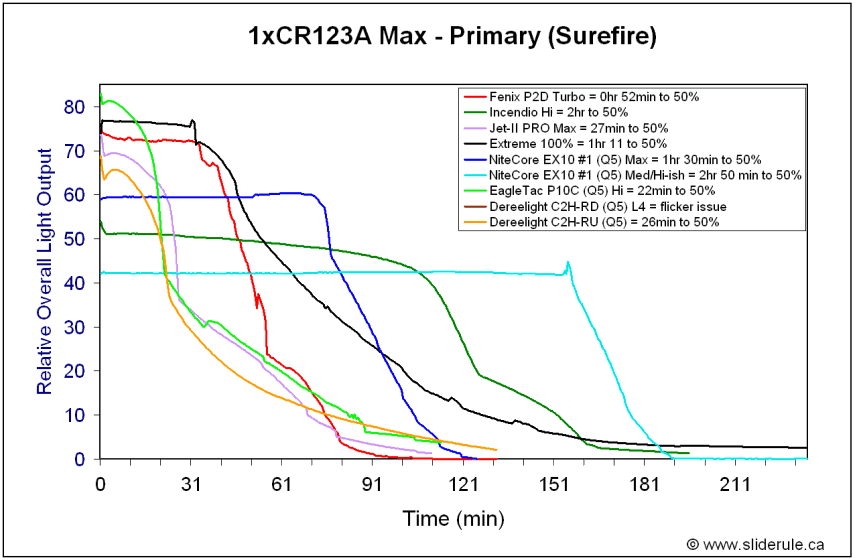
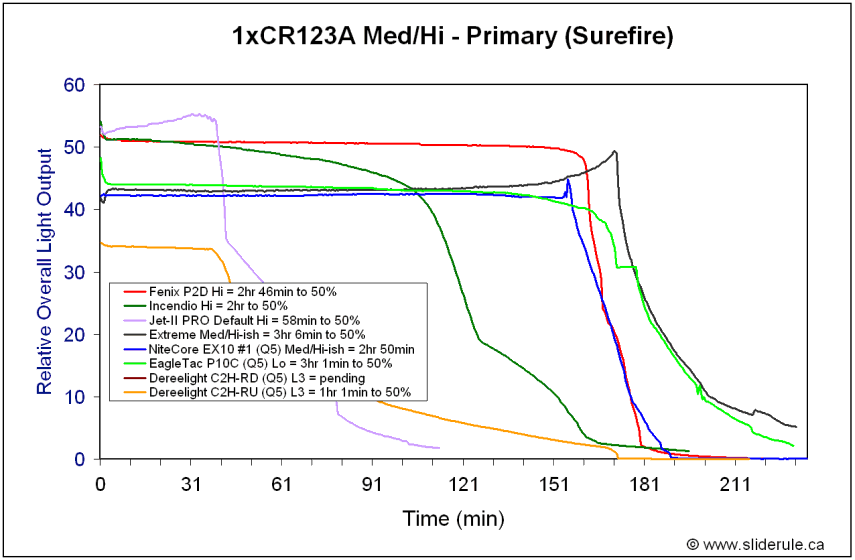
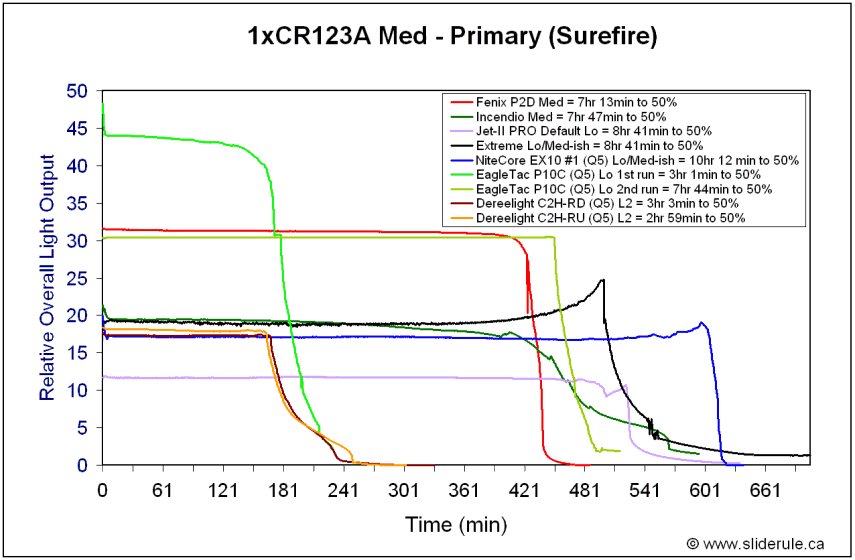
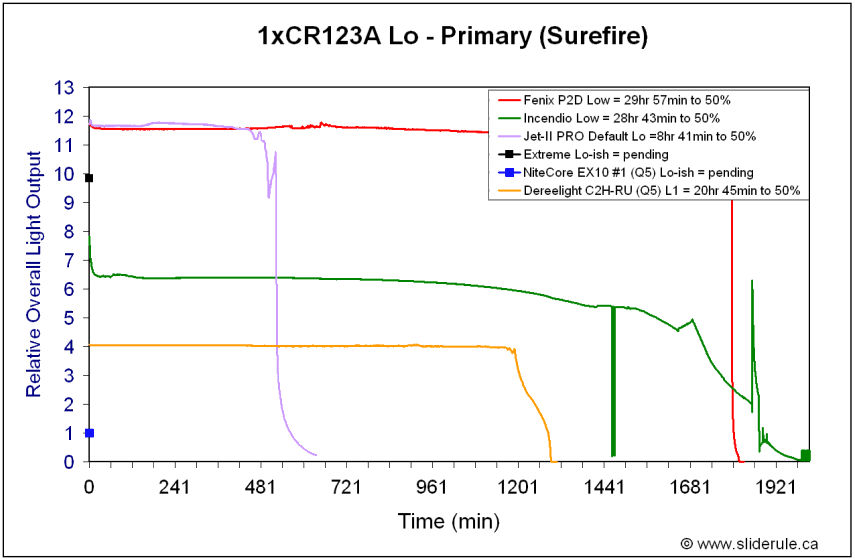
Observations
The main issue with these C2H lights is their relatively low output/runtime efficiency. I don't know what the problem is exactly, but runtimes certainly aren't competitive with other 1xCR123A/RCR lights, especially on Med-Hi settings. :thinking:
Performance was the same for the ramp-up and ramp-down versions - and is consistent with Dereelight's own published specs - so I believe this is typical performance for the circuit.
I notice that my C2Hs heat up more quickly than other lights run at comparable output levels. Of course, that would be consistent with the lower efficiency - all that battery capacity has to be going somewhere, and it may be used up as extra generated heat (as always, my runtimes are all done on a cooling fan - I noticed the lights warming up more quickly when handling during other tests).
I also noticed some warm-tint shifting on L4 ("Burst") compared to L1-3 (Lo-Med-Hi), which seemed to be more pronounced on primary CR123A.
Finally, my RD version had a noticeable flicker on max on primary CR123A. Not sure of the cause, but the replacement RU version Alan sent worked perfectly.
General Observations
The Dereelight C2H is designed to be one of the brightest and smallest multi-stage single-cell CR123A/RCR lights, with built-in flexibility and upgradeability. Up to a point, it succeeds on many of its promises.
Let's start with the key point for many: output. Yes, it is the brightest light on 1xRCR in my collection at the moment - but only for the first 30 secs or so. After that, it drops down to a regulated level that is comparable to a number of highly-driven lights. Also, the C2H seems to be designed for best performance on RCR - on primary CR123A, max output is somewhat less. And of course, the major issue here is output/runtime efficiency (see Potential Issues above).
- but only for the first 30 secs or so. After that, it drops down to a regulated level that is comparable to a number of highly-driven lights. Also, the C2H seems to be designed for best performance on RCR - on primary CR123A, max output is somewhat less. And of course, the major issue here is output/runtime efficiency (see Potential Issues above).
Build-wise, it is probably the most compact heavily-driven light I've come across. :kiss: I'm impressed with how much they've managed to jam into such a small package and still maintain such flexibility. Included OP and SMO reflectors are a particularly nice touch. :thumbsup: Although the need to cut the circuit trace to disable the low-voltage sensor may seem a bit odd, this is actually a good way to easily serve two large battery markets simultaneously.
Readers of my reviews will know that I was a fan of the original tiny EDC - the Lumapower Incendio. I believe the C2H has many of the build characteristics needed to please those who were disappointed by the Incendio (i.e. its hard-to-access clicky, non-accessible pill and switch, ramp-down only, lower output, type II anodizing, etc). The build of the C2H is excellent in my view. Of course, the Incendio still has some potential advantages (i.e. excellent output/runtime efficiency, wide and smooth beam), but that is relative to what matters to you in an EDC.
Of course, the Incendio still has some potential advantages (i.e. excellent output/runtime efficiency, wide and smooth beam), but that is relative to what matters to you in an EDC.
Given the strong design elements of the C2H, I would urge Dereelight to resolve the runtime efficiency issue of the circuit. Although this may not matter so much if you plan to frequently re-charge your RCRs, it is the one blemish on an otherwise strong offering.
P.S.: As an aside, I would like to commend Dereelight for making so many pill/emitter combos available for the C2H - both as a new purchase and as upgrades. The warm 5A tints are becoming particularly popular around here, and are a great option. Dereelight was also very responsive in providing a RU version based on CPF user feedback - which I personally think makes the most sense for an EDC. Well done.

Manufacturer Specs:
- Emitter: choice of Cree XR-E WC Q5, 5A Q3, or R2 emitter
- Four-stage digital (4SD) driver, available in ramp down (RD) or ramp up (RU) sequences
- Battery type: 1xCR123A or 1xRCR.
- Lithium battery over-discharge protection (default). You can use unprotected RCR123; if you want to use CR123A, cut or un-solder a wire on the back of the driver, RE- solder again if you want the protection, details are in the users manual. Lock out function
- Upgradeable components
- Forward clicky
- Reverse polarity protection
- Smooth and O.P. reflector (included)
- HA III hard anodized finish, dark grey color
- Dimensions: 82mm(Length)x 23mm(Head)
- Bezel down clip
- Can tail stand
- Anti-roll design
- Constructed of aircraft grade aluminum
- Water resistant, splash proof or dunkable
- Weight: 46-gram weight not include battery
- Glass: Toughened ultra clear glass lens with double face AR coating
- GITD switch cover, lens o-ring
- Accessories: Gift box, Extra O-ring, Lanyard.

The C2H is Dereelight's first attempt at a small EDC (everyday carry) light. Their approach has a number of unique aspects - e.g. keep it as small as possible, but still highly customizable and upgradeable, and maximally driven for a 1xRCR/CR123A light.
You can purchase it in both ramp up (RU) and ramp down (RD) versions, with identical output levels (i.e. only the sequence is different). Both versions have a memory mode to retain the last setting used. My two samples were of the WC tint Q5 Cree emitter, but 5A Q3 and a limited number of R2 emitters are also available. Price varies depending on configuration, but is typically ~$65. Emitter pill upgrades are also available.
The lights were identical in build, so all the pics below are from the RD version.

The lights come in hard cardboard boxes with magnetic closing flaps. Inside, you'll find the light encased in cut-out foam with instruction manual, additional reflector (SMO and OP included, one installed in the light), extra o-rings, and wrist lanyard.



As you can see, the light includes a bezel-pointing clip and can tailstand. The forward clicky switch has a good feel and is easy to access (you can un-screw the retaining ring around the tailcap cover, just like the Nitecore Extreme).
User interface is press for momentary on, click for lock-on Advance modes by soft-pressing the clicky. Light uses PWM for low modes, but at such a high frequency that I can't detect it. :thumbsup:
The pill and reflectors are also easy to access and replace.
Note that on my RU sample, there was a small spring soldered onto the center of the contact disc in the head (not shown in the RD pics here). I don't know if this is now standard on C2H lights. Aside from this, there are no visible differences between my RU and RD samples.
Labels are quite clear and sharp, and I personally like dark grey natural HA colour. GITD rings and tailcap button are fairly bright by GITD standards.

Shown above is the textured (OP) reflector, but the SMO is exactly the same dimensions. Here is how their beam patterns differ (both WC Q5):



As you can see, the SMO reflector throws further, but has a more traditionally ringy Cree beam. Note that the SMO produces a tightly defined hotspot, with relatively little corona (reminiscent of the Olight 2-stage reflector, IMO).
A key feature of the C2H is the low-voltage Li-ion shut-off circuit (on by default). This allows you to run non-protected RCRs in the light safely. But it prevents you from running primary CR123A (which are lower voltage to start with). If you want to run CR123A, you need to cut the circuit trace shown on the contact surface in the head (see pics below)


You don't need to be as thorough as I was above - a slight cut is all that is required. You can restore low-voltage shut-off by re-soldering the contact.
Comparisons

From left to right, Duracell CR123A battery, Dereelight C2H, Nitecore EX10, Lumapower Incendio V1, JetBeam Jet-II PRO, Nitecore Extreme, Novatac 120P
As you can see, the C2H is quite small for a heavily-driven light, not much bigger than the Indendio or EX10.
For beamshots, below is a comparison of the C2H with OP reflector to some other lights, all lights on AW RCR (black label) on max, ~0.5 m from a white wall.






Testing Method: All my output numbers are relative for my home-made light box setup, a la Quickbeam's flashlightreviews.com method. You can directly compare all my relative output values from different reviews - i.e. an output value of "10" in one graph is the same as "10" in another. All runtimes are done under a cooling fan, except for the extended run Lo/Min modes which are done without cooling. Throw values are the square-root of lux measurements taken at 1 meter from the lens, using a light meter.
Throw/Output Summary Chart:

As you can see, the C2H is definitely one of the bright single cell EDC lights on RCR, at least initially. Scroll down to the runtimes for a more thorough output analysis. Throw is quite good for the size.
Output/Runtime Comparison:
For these comparisons, I've labelled the lights output levels from lowest output to max output in order (i.e. L1 is lowest, L4 is highest). I've noticed on the forums that most people refer to these levels as Lo-Med-Hi-Burst.







Observations
- Max output on RCR is initially higher than any of my other 1xRCR lights, but quickly drops to a regulated level that is more consistent with a number of lights.
- Max output on primary CR123A (after cutting the low-voltage circuit) was lower than RCR.
- As you can see, output/runtime efficiency of my C2H samples are clearly lower than other lights in this class, especially on Med-Hi settings. :shrug:
- There was no significant difference in output between the RU and RD versions.
The main issue with these C2H lights is their relatively low output/runtime efficiency. I don't know what the problem is exactly, but runtimes certainly aren't competitive with other 1xCR123A/RCR lights, especially on Med-Hi settings. :thinking:
Performance was the same for the ramp-up and ramp-down versions - and is consistent with Dereelight's own published specs - so I believe this is typical performance for the circuit.
I notice that my C2Hs heat up more quickly than other lights run at comparable output levels. Of course, that would be consistent with the lower efficiency - all that battery capacity has to be going somewhere, and it may be used up as extra generated heat (as always, my runtimes are all done on a cooling fan - I noticed the lights warming up more quickly when handling during other tests).
I also noticed some warm-tint shifting on L4 ("Burst") compared to L1-3 (Lo-Med-Hi), which seemed to be more pronounced on primary CR123A.
Finally, my RD version had a noticeable flicker on max on primary CR123A. Not sure of the cause, but the replacement RU version Alan sent worked perfectly.
General Observations
The Dereelight C2H is designed to be one of the brightest and smallest multi-stage single-cell CR123A/RCR lights, with built-in flexibility and upgradeability. Up to a point, it succeeds on many of its promises.
Let's start with the key point for many: output. Yes, it is the brightest light on 1xRCR in my collection at the moment
Build-wise, it is probably the most compact heavily-driven light I've come across. :kiss: I'm impressed with how much they've managed to jam into such a small package and still maintain such flexibility. Included OP and SMO reflectors are a particularly nice touch. :thumbsup: Although the need to cut the circuit trace to disable the low-voltage sensor may seem a bit odd, this is actually a good way to easily serve two large battery markets simultaneously.
Readers of my reviews will know that I was a fan of the original tiny EDC - the Lumapower Incendio. I believe the C2H has many of the build characteristics needed to please those who were disappointed by the Incendio (i.e. its hard-to-access clicky, non-accessible pill and switch, ramp-down only, lower output, type II anodizing, etc). The build of the C2H is excellent in my view.
Given the strong design elements of the C2H, I would urge Dereelight to resolve the runtime efficiency issue of the circuit. Although this may not matter so much if you plan to frequently re-charge your RCRs, it is the one blemish on an otherwise strong offering.
P.S.: As an aside, I would like to commend Dereelight for making so many pill/emitter combos available for the C2H - both as a new purchase and as upgrades. The warm 5A tints are becoming particularly popular around here, and are a great option. Dereelight was also very responsive in providing a RU version based on CPF user feedback - which I personally think makes the most sense for an EDC. Well done.
Last edited:


 But Dereelight has been quite responsive to user feedback in the past, so I wouldn't be surprised if they came out with a revised pill soon.
But Dereelight has been quite responsive to user feedback in the past, so I wouldn't be surprised if they came out with a revised pill soon.



 ).
).



